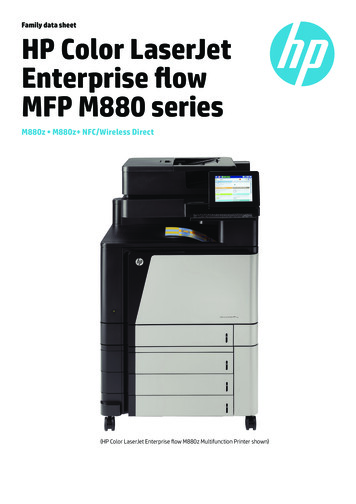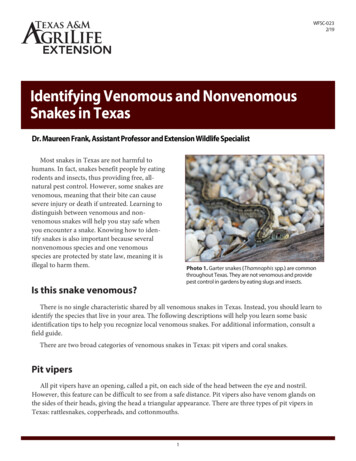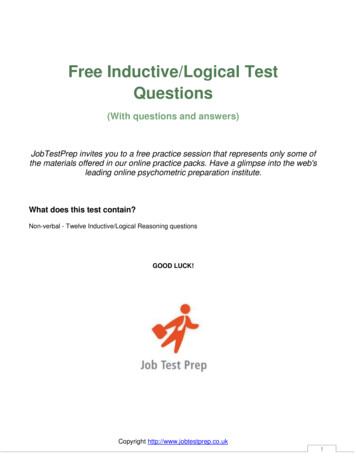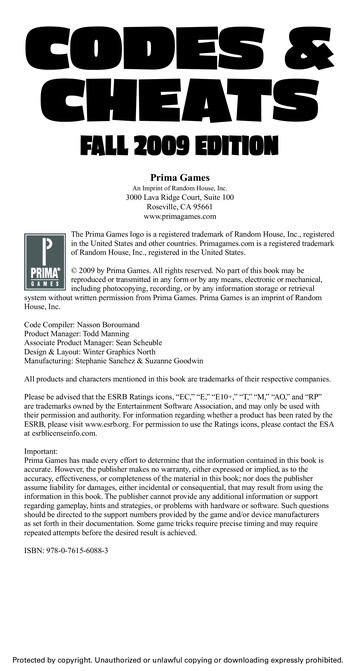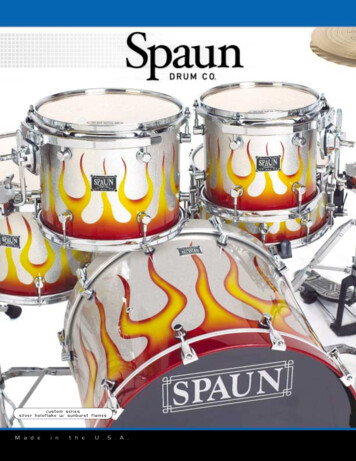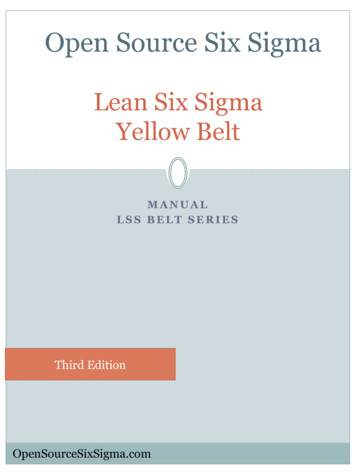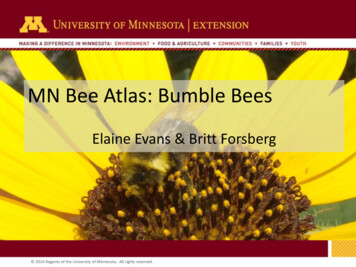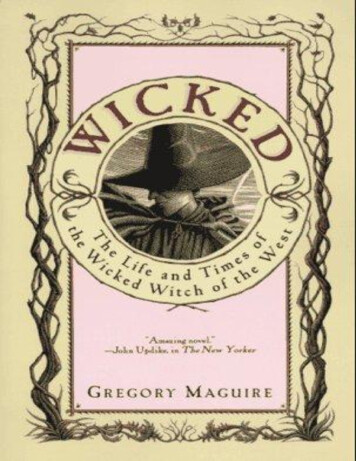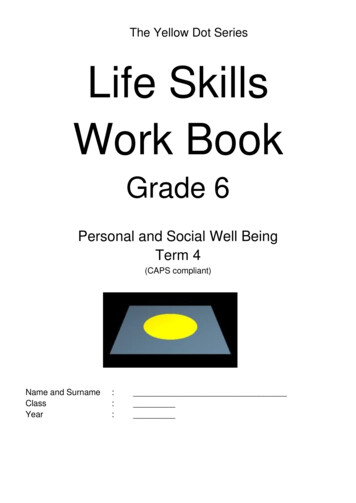
Transcription
The Yellow Dot SeriesLife SkillsWork BookGrade 6Personal and Social Well BeingTerm 4(CAPS compliant)Name and SurnameClassYear:::
1Life SkillsGrade 6Personal and Social Well-beingTerm 4Module 13First aid in different situations (Week 1)Unit 13.1: Basic first aid in the following situations:Cuts and abrasions, Burns, Scalds and Sunburn, Bruises, Choking,Stings and Bites (pg2)Unit 13.2: Read about First Aid for poisoning (pg10)Unit 13.3: Interpret and explain (pg12)Module 14Food Hygiene (Week 2-4)Unit 14.1: Safe and harmful ingredients in food (pg14)Unit 14.2: Food storage and preparation (pg18)Unit 14.3: Food-borne diseases (pg20)Unit 14.4: Read, interpret and explain (pg21)Module 15Communicable Diseases (Week 5-7)Unit 15.1: What is a communicable disease? (pg22)Unit 15.2: Causes, symptoms, treatment and prevention (pg23)Unit 15.3: Where to find information (pg24)Unit 15.4: Read, interpret and explain (pg24)Module 16HIV and AIDS education (Week 8)Unit 16.1: Myths and Facts (pg28)Unit 16.2: Caring for people with AIDS (pg31)Unit 16.3: Read, interpret and explain (pg31)Consolidation and Formal AssessmentExamination (Week 9-10)
2Module 13First Aid in different situationsUnit 13.1 – Basic First AidThe three most important aims of basic first aid are to aid healing, to reduce therisk of infection and to provide assistance until professional help can be found.Cuts and AbrasionsCuts and abrasions are injuries that break or remove the skin. Most small cuts andabrasions can be treated successfully at home. Large wounds 1 or severebleeding must get medical attention because blood loss can lead to falling bloodpressure, shock and even death.Minor cuts and abrasionsHold the wound under running water to remove dirt. Wash the skin around the wound with soap and water.2345 Pat the wound dry with sterile gauze and apply antiseptic ointment . Most minor cuts and abrasions stop bleeding on their own. However, if thebleeding continues, apply pressure to the wound with a clean bandage. In the case of small cuts, close the wound with sterile plaster.Don’t use cotton wool – the fibres will get stuck in the wound.67 Change the dressings at least once a day and watch for infection –remember that an infection will only be obvious after a day or two. 1Wound (Say: whoo nd) - an injury caused by a cut, blow or other impact.Sterile (Say: stair eye l) – free from germs – totally clean3Gauze (Say: gore z) – a thin, almost see through material that has a loose weave4Antiseptic (Say: ant ee sep tick) – something that prevents the growth of germs51. Ointment (Say: oynt mint) - a smooth oily substance that is rubbed on the skin6Dressing (Say: dress sings) – a piece of material that is used to cover or protect an injury7Infection (Say: in fek shin) – the presence of germs2
3Serious cuts For deeper cuts or severe1 bleeding, press on the wound witha clean towel or gauze and get professional help. Deeper cutsmight need stitches to keep the wound closed.2 Try to elevate the area that is bleeding. If there is an object in the wound, don’t try to remove it.Get help if The wound is large or deep and bleeding has not stoppedafter 10 minutes of applying pressure.3 The person has lost of lot blood and is sleepy or pale . There is something stuck in the wound. The person cannot move his fingers or toes. Stitches are required. The wound is on the face or neck.Burns, Scalds and SunburnBurns and scalds are damage to the skin caused by heat. A burn is caused by dryheat, e.g. a hot iron, the sun or fire. A scald is caused by something wet, such ashot water or steam.A BURN1Severe (Say: siv ear) – serious/something to worry aboutElevate (Say: eh live eight) – to lift up or lift higher3Pale (Say pay yil) – colourless/faded/almost white2A scald
4Burns and scalds can be very painful and can cause blisters and charred1, blackor red skin. Skin damage caused by heat is grouped according to the degree2ofdamage to the skin. The groups are known as first, second and third degreeburns.st greeDegreeBurnIt is possible to treat some 1st degree burns at home. However, 2nd and 3rd degreeburns as well as any burns that are bigger than hand sized should getprofessional medical attention after basic first aid has been carried out.Treating burns and scalds Get the person away from the heat source to stop the burning.Cool the burn with cool or lukewarm water for 10 to 30 minutes – do not use ice,iced water or any creams or greasy substances such as butter. If blisters have formed on the skin, DO NOT pop them. Special creams for sunburnt skin are available – ask a doctoror pharmacist for the correct lotion. Cover a serious burn by placing a layer of cling film over it. 12Charred (Say: char d) – burnt in such a way that the object is blackened by heatDegree (Say: dir gree) – a level or amount
5BruisesA bruise is dark discolouration of skin caused by blood seeping under the skinafter small blood vessels near the surface of the skin have been broken. As thebruise heals, the body breaks this blood down and reabsorbs it, turning the area agreenish-blue colour.Treating bruises Most bruises are not very serious and will get better on their ownover a period of about ten days. If the bruise is quite large and swollen, then you can apply ice packs toreduce the swelling. This will also relieve the pain. Elevate the area if the bruise is on a leg or an arm. Get help if A bruise doesn't fade within 14 days.The person is in pain for more than 24 hours or if pain on the site of thebruise gets worse - this may be caused by a broken bone.ChokingChoking occurs when a foreign object1 becomes stuck in the throat or windpipe,blocking the flow of air. In adults, a piece of food often is the culprit2. Youngchildren often swallow small objects. Because choking cuts off oxygen to thebrain, first aid must be carried out as quickly as possible.Windpipe to lungsRoute to stomachObject stuck inwindpipe. Air cannotmove past the object.12Foreign object (Say: foh rin - ob jekt) – something that is not normally present or that doesn’t belong thereCulprit (Say: kull pritt) – the thing or person that is guilty
6What to do if somebody is chokingInfants (Babies younger that one year)1.2.3.4.5.Sit down. Hold the baby face down on your forearm and rest it on your leg.Thump the infant gently but firmly five times on the middle of the back usingthe heel of your hand.If this doesn’t work, hold the infant face up on your forearm with the head lowerthan the body. Using two fingers placed at the centre of the infant'sbreastbone, give five quick chest compressions.Repeat the back blows and chest thrusts five times if required.If breathing doesn't resume, call for emergency medical help.Adults and children over the age of onePerform abdominal thrusts (Heimlich manoeuvre): Stand behind the person. Wrap your arms around the waist. Tip the personforward slightly.Make a fist with one hand. Position it slightly above the person's belly button.Grasp the fist with the other hand. Press hard into the abdomen with a quick,upward thrust - as if trying to lift the person up.Perform a total of 5 abdominal thrusts, if needed. If the blockage still isn'tdislodged, try another 5 thrusts.Self Place a fist slightly above your belly button.Grasp your fist with the other hand and bend over a hard surface- a countertop or chair will do.Shove your fist inward and upward.
7Insect Stings and BitesSouth Africa has many insect species 1 that can bite or sting human beings.Mosquito, bee, wasp, bedbug, tick and flea bites are the most common insectbites.beemosquitofleawaspbedbugtickMost insect bites and stings, although itchy or slightly painful, cause very littleharm to a person. However, some people are allergic to the venom2 that someinsects inject when they sting or bite so it is useful to know what action to takewhen somebody has an allergic reaction.Treating minor bites and stings Relieve the itching with an ice cube or cloth dipped in cold water. Special creams can also stop the itching or stinging. Remove a bee stinger by gently scraping the skin with the blunt edge of aknife or your fingernail. Do this as quickly as possible to avoid furtherinjection of venom. Don't grasp the stinger or rub the skin. If a tick is found, remove it immediately: grip it with fine-tipped tweezers asclose to the skin as possible and pull it out in a straight line - don't jerk ortwist. Make sure the head is also removed. If the head remains behind, itcould cause a small necrotic ulcer3 ('veld sore'). Wash the bite area with soap and water.1Species (Say: Spee sees) – a scientific word for a group of animals that have something in common, e.g. feathers/scalesVenom (Say: veh nim) – a poisonous substance secreted by some animals and plants3Ulcer (Say: ull sir) – an open sore (without a scab) that can be on the skin or inside the body2
8Get help ifSigns of a severe allergic reaction develop.There is a history of previous severe reaction to theinsect's bite - don't wait for the reaction to occur.The face, neck or throat is stung. This may causeswelling which could obstruct1 the airway. There are multiple stings. Spider and Scorpion Stings and BitesSpider bites can make a reddened wheal2 and an ulcer.In serious cases there is severe pain around the bite. Thevenom that some spiders and scorpions inject when theybite causes sweating, muscle cramps and fever.Only a few species of spiders are dangerous. In South Africa, the Button, Sac,Violin, Six-eyed crab, Black widow and Brown widow spiders cause the mostharmful reactions.12Button spiderSac spiderViolin spiderSix eyed crab spiderBlack widow spiderBrown widow spiderObstruct (Say: Ob strukt) – to be in the way of something or to stop something from going somewhereWheal (Say: wheel) – a red, swollen mark on the skin
9All scorpions found in South Africa are venomous but only the stings from theButhidae group (thick tails and thin pinchers) can be fatal1 to human beings.Scorpion stings can cause burning pain, numbness and tingling across the body,nausea, vomiting, stomach pain, blurred vision, slurred speech, difficulty breathingor swallowing and shock.Treating spider bites and scorpion stingsCall emergency services for any scorpion sting,and any bite from a dangerous spider.2 Keep the affected limb lower than the heart.Clean the wound and apply an ice pack to reduce swellingand stop the spread of venom. Snake BitesThere are between 130 and 160 different species of snakes in South Africa. Mostof them are not dangerous to humans. However, unless you are an expert atsnake identification, it is always better to treat any snake with caution3. Alsoremember that snakes to not eat human beings so they will only attack when theyare startled or feel that they are in danger.Venomous snakes found in South AfricaCape Cobra1Black mambaFatal (Say: fay till) – deadly/causing something to dieLimb (Say: lim) – an arm or a leg3Caution (Say: caw shin) – with a lot of care2Puff adderBoom slang
10A bite from a venomous snake can be deadly, and should always be treated as amedical emergency. Even a bite from a harmless snake can be serious, leading toan allergic reaction or an infection. Venomous snake bites can result in pain in thebite area, swelling, convulsions1, nausea 2 and even paralysis3.There are first aid steps you can take after a snake bite occurs, such as cleaningthe wound, remaining calm, and immobilizing4 the affected area. However, it isessential to get the bite victim to a medical facility immediately for emergencytreatment. If treated in time, the outlook for recovery is good.Unit 13.2 – Read about First Aid for poisoningMore than 2 million poisonings are reported each year across thecountry. Poisoning is caused by swallowing, injecting, breathingin, or otherwise being exposed to a harmful substance. Mostpoisonings occur by accident. Immediate first aid is veryimportant in a poisoning emergency. The first aid you give beforegetting medical help can save a person's life.Signs and symptoms of poisoningCommon signs and symptoms to look for include: Burns or redness around the mouth and lips, from drinking certain poisons. Breath that smells like chemicals, such as petrol or paint thinner. Burns, stains and smells on the person, on clothing, or objects in thesurrounding area. Empty medication bottles or scattered pills. Vomiting, difficulty breathing, sleepiness or lessnessLoss of consciousnessConvulsion (Say: kon vul shin) - a sudden, violent, irregular movement of the body, that is not done on purposeNausea (Say: naw zjee ahh) – a feeling as if you want to vomit3Paralysis (Say: pir al a sis) – not able to move4Immobilizing (Say: eem oh bill eye zing) – keeping still2
11Who to call for helpCall the local emergency services or Poison Control Centre. Provide informationabout the person's symptoms, age and weight, and any information you haveabout the poison, such as amount and how long since the person was exposed toit. It helps to have the pill bottle or poison container on hand when you call.Write your local poison control centre number hereWrite your local poison control centre number hereWhat to do while waiting for help There are some things you can do for the person until help arrives:If the person has been exposed to poisonous fumes, get him or her into freshair immediately.If the person swallowed the poison, remove anything remaining in the mouth.If the suspected poison is a household cleaner or other chemical, read thelabel and follow instructions for accidental poisoning. If the product is toxic, thelabel will likely advise you to call the poison centre.Follow treatment directions that are given by the poison control centre.If the poison spilled on the person's clothing, skin or eyes, remove the clothing.Flush the skin or eyes with cool or lukewarm water, such as by using a showerfor 20 minutes or until help arrives.Make sure the person is breathing. If not, start CPR and rescue breathing.Take the poison container or sample of the poison (or any pill bottles) with youto the hospital.What NOT to do Do not give an unconscious person anything to eat or drink.Do not try to get the person to vomit unless you are told to do so by the PoisonControl Centre or a doctor. A strong poison that burns on the way down thethroat will also do damage on the way back up.Do not try to neutralize the poison with lemon juice or vinegar, or any othersubstance, unless you are told to do so by the Poison Control Centre or adoctor.Adapted from: oning/basics/art-20056657
Unit 13.3 – Interpret and Explain12Activity 13.3.1Complete the following activities in your Life Skills book. Use the followingheading: First Aid in Different SituationsCuts and AbrasionsFill in the missing words for each of the following. Write the whole sentence outand underline the words that you have filled in:1.2.3.4.5.Cuts and abrasions are injuries that orthe skin.When a cut results in severe bleeding you must get medical attention becauseblood loss can lead to falling .An abrasion should be patted with sterile to dry it outbefore applying ointment.Don’t use on an abrasion or a cut because theywill get stuck in the wound.If there is an in a cut, don’t try to it.Burns, Scalds and SunburnSelect the answer that is most correct. Write only the letter of the answer youhave selected.1.2.3.A serious burn should be covered with cling filma. to reduce the risk of germs that could cause infection from entering the areaof the burn.b. to keep the burn area cool.c. To stop any fibres from clothes touching the burn area.Sunburn is usually an example ofa. a 1st degree burnb. a 2nd degree burnc. a 3rd degree burnWhat is the difference between a burn and a scald?a. There is no difference.b. A burn is caused by dry heat and a scald is caused by wet heat.c. A burn is caused by fire and a scald is caused by water.
13BruisesList two basic first aid steps that can be used to treat bruises.ChokingPut the following steps, for treating an infant who is choking, into the correct order.Only write the number for each step, as shown below.1. Hold the infant face up on your forearm with the head lower than the body.Using two fingers placed at the centre of the infant's breastbone, give five quickchest compressions.2. Sit down.3. Hold the baby face down on your forearm and rest it on your leg.4. Repeat the back blows and chest thrusts five times if required.5. Thump the infant gently but firmly five times on the middle of the back using theheel of your hand.6. If breathing doesn't resume, call for emergency medical help.1st step2nd step3rd step4th step5th step6th stepStings and BitesAnswer the following questions. Write only a yes or a no.1.2.3.4.5.6.7.Are all scorpions venomous?Is the sting of all scorpions fatal to human beings?Can a spider bite cause a skin ulcer?Is a common rain spider venomous?Are Violin spiders found in South Africa?Can a bee sting be fatal?Can a tick head that is left in a person’s skin cause a necrotic ulcer?Snake BitesState whether the following sentences are true or false. If a sentence is false,then write the sentence out correctly.1.2.3.A bite from a non- venomous snake is not serious.Snakes stalk and attack human beings.A Boom slang and a Cape Cobra are poisonous snakes that can be found inSouth Africa.
14First Aid for PoisoningProvide logical, well thought out answers to the following questions:1. Poison can enter the human body by being swallowed, injected, breathed in orby being absorbed through the skin. Which one do you think is most common?Provide a reason for your answer.2. Why do you think it is important to give the pill bottle or substance that causedthe poisoning to the emergency room doctor?3. Children between the ages of 2 and 8 are the most common victims ofaccidental poisoning in the home. Provide a reason for this.Module 14Food HygieneUnit 14.1 – Safe and harmful ingredients in foodFood and drink is usually at its tastiest and most nutritious1 when it is fresh.However, it is not always possible for everybody to get fresh food on demand.Some foods are seasonal, some start going rotten after a short time and otherfoods can only be found in places that are far away. This means that humanshave had to try and find ways of preserving2 food so that it can be stored andused at a later time without losing its taste or its nutritive value.The preservation of food is often called ‘processing’. Long ago, there were notmany ways to preserve food and drink. Processes such as drying, smoking,pickling and jamming were popular ways of preserving food. Many of theseprocesses are still used today. More recent ways of preserving food includerefrigeration, freezing, canning, vacuum packing, irradiation and pasteurisation.12Nutritious (Say: new tree shus) – filled with good minerals and vitaminsPreserve (Say: pree zirv) – to make something last for longer
15Activity 14.1.1Work on your own. Provide a suitable label for each method of preserving food.Write the answers in your Life Skills book. Use the heading: Ways of preservingfood.AECBFDGIn order to process food and preserve it, something is usually added or taken outof the food. Most of the processed food that we eat today consists of the followingadded ingredients: salt or sugar; preservatives; colourants; flavourants; artificialsweeteners; vitamins and minerals. Some of the ingredients that are added arebeneficial1 but others may be harmful to a person’s health. Some researchersthink that the use of preservative chemicals causes weight gain, asthma, heartdisease and even cancer.Because a lot of the food we purchase in shops today is not in its natural form,manufacturers are legally required to put nutritional information on foodcontainers. This allows consumers to decide whether the ingredients in the foodwill be beneficial or harmful to them. Here are some of the nutrients andingredients that you might see on a nutrition label:CarbohydratesThe cells in your body produce glucose (pronounced 'gloo-kohws') fromcarbohydrates. Glucose gives you quick energy. Your body’s cells can't use a lotof glucose all at once so some glucose is stored in your liver and muscles, asglycogen (pronounced 'gly-koh-jin). Once there is enough glycogen stored in yourliver and muscles the rest turns into fat.1Beneficial (Say: ben a fish ull) – something that has value
16SugarSugar is a type of carbohydrate found in a variety of foods, including fruit andvegetables. Too much sugar can lead to diabetes, and cancer.ProteinProtein builds up your muscles, organs and glands. It helps repair and replacethem too, so that your body can keep on working.FatFat is useful because it acts as the body's reserve tank of energy. It protects ourorgans (like a cushion) and it helps our bodies stay warm in cold weather. Toomuch fat in a diet can lead to obesity 1 and can cause illness such as heartdisease and high cholesterol2.SodiumSodium is a part of salt: table salt is 40% sodium and 60% chloride. Processedand preserved food items such as canned foods, fast foods and cheese usuallyhave high sodium content. Sodium is needed by the body for maintaining properblood pressure. Too much sodium can lead to high blood pressure, heart attackand strokes.FibreFibre is an important part of a healthy diet. Fibre can help prevent heart disease,diabetes, weight gain and some cancers. It can also improve digestion.VitaminsVitamins are stored in the fatty tissues of your body and in the liver. Some arestored for a few days and others for months, until your body needs them. Hereare a few examples of vitamins and what they do.Vitamin AHelps you see at night and help your body fight infections.Vitamin DHelps to make strong bones.Vitamin EHelps to protect your skin.Vitamin KHelps to stop bleedingVitamin CHelps to fight infections.Vitamin BHelps to make energy and protein and red blood cells.12Obesity (Say: oh bee city) – extremely fatCholesterol (Say: koh less tah rol) – a fatty layer on the inside of veins and arteries that stops blood from flowing correctly
17MineralsThere are many minerals in food and some of them are essential for a healthybody. Zinc is so powerful that you only need a bit to help you grow. It is found inmeat, fish and poultry (chicken and other birds.) Iron helps create the red bloodcells which carry oxygen through your body. It gives the body lots of energy. Ironis found in red meat, liver, and some cereals. Calcium builds strong bones andteeth. It is found in dairy foods like milk, yoghurt and cheeses.PreservativesSome forms of food processing remove the taste andnatural colour of the food so artificial flavours andcolours have to be added to make the food taste andlook good. These flavourants and colourants don’talways have nutritional value and sometimes they areunhealthy.Natural preservatives, such as sugar and salt, andchemical preservatives, such as sulphur dioxide, areused to make food last for longer. While the natural andchemical preservatives are helpful because they stopbacteria from making the food decay, many of thesepreservatives can be harmful to our bodies.Activity 14.1.2Work in groups of 2-3. Look at the nutrition information on the food labels below.Discuss which foods are healthier to eat. Take care to look at the quantities andserving portions when you make your decisions.Nutrition ary FibreSugarsVitamin AVitamin ECalciumIronPotassiumSodiumArtificial flavourantArtificial colourantskJgggggmgmgmgmgmgmgPer 100gserving54715610100602330180YesNoNutrition ary FibreSugarsVitamin AVitamin CCalciumIronPotassiumSodiumArtificial flavourantArtificial colourantskJggggmgmgmgmgmgmgPer 30gserving1302214036214100115YesNo
18Nutrition ary FibreVitamin AVitamin ECalciumSugarsSodiumkJggggmgmgmggmgArtificial flavourantArtificial colourantsPer 1biscuit31410.21.160.20004.844.3YesYesNutrition ary FibreSugarsVitamin CVitamin ECalciumIronSodiumArtificial flavourantArtificial colourantskJgggggmgmgmgmgmgPer 1 cupserving1202611.51130034108YesYesNutrition ary FibreVitamin AVitamin ECalciumSugarsSodiumkJggggmgmgmgmgArtificial flavourantArtificial colourantsPer 4biscuits406153.16.520022.1156NoNoNutrition ary FibreSugarsVitamin CVitamin ECalciumIronSodiumArtificial flavourantArtificial colourantskJgggggmgmgmgmgmgPer 1 cupserving160464110120021050NoNoUnit 14.2 – Food storage and preparationMicro-organisms including bacteria, viruses and moulds found in food can causefood poisoning and this leads to unpleasant symptoms such as stomach pains,diarrhoea and vomiting. Food poisoning can sometimes lead to gastroenteritis,which is inflammation of your stomach and bowel, or even more serious healthproblems, such as blood poisoning (septicaemia) and kidney failure.If you remember a few simple things about food preparation and storage, you canreduce the chances food poisoning.CleaningOne of the most important things you can do is to make sure thatyour hands are clean at all times – although it sounds simpleenough, many of us are guilty of forgetting at some point.Cleaning your hands doesn’t mean just passing your hands underthe tap – give them a proper scrub with soap. In particular,remember to wash your hands: after using the toilet
19 before you handle any foodafter you handle raw meatBefore you start to prepare any food, make sure that the area you’re working inand the utensils you are using are clean. Clean worktops very well and washutensils with washing-up liquid and hot water. Make sure you clean up any spiltfood straight away.Change all drying and washing cloths regularly because bacteria often multiply onthese items, especially if they are damp.StoringRead the safe storage instructions on food. If you store food in the wrong place orat the wrong temperature, it can lead to the growth of bacteria. Proper storage offood reduces the risk of food poisoning. Follow these tips to ensure your food issafe to eat. Always check labels for guidance on where to store food. Store fresh and frozen food in the fridge or freezer as soon as possible afteryou buy it. This is especially important in hot weather. Keep raw meat and seafood separate from other foods. Store raw meat in an airtight container at the bottom of the fridge to preventjuices or blood dripping onto other food. Defrost frozen foods in the fridge. Place them on a plate or in a container asthey defrost, so they don't drip onto or contaminate other foods. Don't store opened tins of food in the fridge – transfer the contents to a suitableairtight container instead. If you’re keeping cooked leftovers, allow them to cool to room temperaturebefore you store them in the fridge. Make sure you use up any leftovers withintwo days. Throw away any food that has passed its use-by date. Store food such as bread or biscuits in an airtight container to slow down thegrowth of bacteria or mould.PreparingHere are a few points to remember when it comes to preparing food. Don't handle food if you have stomach problems, such as diarrhoea orvomiting, or if you're sneezing or coughing regularly. Check food labels before you decide what to use. Shop-bought foods maycome with two dates: a use-by date and a best before date. Don’t use anyfoods that have passed their use-by date, even if you think they look fine, asthey may not be safe to eat. Keep anything that should be refrigerated out of the fridge for as short a timeas possible, especially if the temperature is high or the room is very warm.
20 Always use different chopping boards and utensils to prepare raw meat orchicken or fish. This is because they contain harmful bacteria that can spreadto anything they touch, so it’s important to keep these away from other foods.Unit 14.3 – Food-borne DiseasesWhat is a food-borne disease?A food-borne disease is an infection or irritation ofany part of the digestive tract that is caused by foodor drinks that contain harmful bacteria, parasites,viruses, or chemicals.Most food-borne diseases happen suddenly and lasta short time. The medical word for this is an ‘acute’illness. Most people recover from a food-bornedisease on their own, with some basic first aid.Sometimes, though, food-borne disease can lead tomore serious complications.Who can get a food-borne disease?Anyone can get a food-borne disease. However,infants and children, pregnant women and theirunborn children, older adults and people with lowimmune systems are at greater risk of developingsevere symptoms or complications from food-bornediseases.What are the symptoms of food-borne disease?Symptoms of food-borne disease depend on the type of microorganism that hascaused the food poisoning. However, many food-borne diseases share commonsymptoms including:VomitingDiarrhoea or bloody diarrhoeaAbdominal painFeverChillsHow are food-borne diseases prevented?Food-borne diseases can be prevented by properly storing, cooking, cleaning, andhandling foods.
21Unit 14.4 – Read, Interpret and ExplainWork on your own. Read the following case study.The Snugro family lives in Pretoria. In summer, the days canget very hot and today was one of those days. At about 2o’clock, Mrs Snugro decided that the family should have abraai so that she did not have to stand in the kitchen and cookin such hot weather.She checked the fridge to see what food she had for the braai. She foundsome tomatoes, cucumber and a lettuce that she
knife or your fingernail. Do this as quickly as possible to avoid further injection of venom. Don't grasp the stinger or rub the skin. If a tick is found, remove it immediately: grip it with fine-tipped tweezers as close to the skin as possible and pull it out in a straight line -

